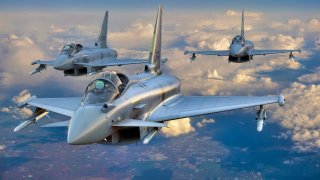Eurofighter Typhoon: The Fighter Jet NATO Is Now Depending On
In March 2024, six Royal Air Force Eurofighter Typhoons were deployed to Romania's Mihail Kogălniceanu Air Base for NATO's enhanced Air Policing mission, marking 30 years since the Typhoon's first flight.
Summary: In March 2024, six Royal Air Force Eurofighter Typhoons were deployed to Romania's Mihail Kogălniceanu Air Base for NATO's enhanced Air Policing mission, marking 30 years since the Typhoon's first flight. Developed by Germany, Great Britain, Italy, and Spain, these multi-role combat aircraft will undertake air policing missions alongside the Romanian Air Force until August 2024. This deployment, the RAF's fifth in Romania since 2014, underscores NATO's commitment to securing its airspace in response to security challenges, particularly following Russia's annexation of Crimea, and showcases the enduring frontline capability and strategic importance of the Eurofighter Typhoon within the alliance.
RAF Typhoons Bolster NATO's Air Policing in Romania: A 30-Year Legacy in Action
In late March 2024, six Royal Air Force (RAF) Eurofighter Typhoons landed at Romania's Mihail Kog lniceanu Air Base in support of NATO's enhanced Air Policing (eAP) mission. It came almost 30 years to the day that the Typhoon took its maiden flight in Manching, Bavaria – and highlights how the aircraft remains a frontline capable warbird.
The all-weather, twin-engine, multi-role combat aircraft that can be employed in air-to-air and air-to-ground combat was developed jointly by four European countries: Germany, Great Britain, Italy, and Spain. And now for the next four months, the RAF fighter jets from RAF Lossiemouth in Scotland – along with roughly 200 personnel – will carry out enhanced air policing missions under NATO command alongside the Romanian Air Force.
"This will be the RAF’s fifth eAP rotation in Romania, having completed the first iteration in 2014," said Wing Commander Karl Bird, Commanding Officer of 140 Expeditionary Air Wing. "The missions contribute to the development of the reaction and deterrence capacity and is a strong sign of the Alliance’s cohesion. Ensuring NATO is ready to secure the skies 24/7."
The deployment of the multi-role combat aircraft to Mihail Kog lniceanu Air Force Base will assist with the Quick Reaction Alert (QRA) missions until August 2024, to respond to current security challenges, NATO announced via a statement. Such eAP deployments are planned in advance and rotate between NATO Allied Air Forces, and ensure collective deterrence and defence protecting and securing the integrity of NATO's airspace.
eAP – A Response to Russian Aggression
The transatlantic military alliance introduced eAP in the south in 2014, following Russia's illegal annexation of Crimea, as a measure to reassure allied nations along the eastern flank.
"Our Nato air policing deployment helps to keep Europe’s skies secure, and I pay tribute to the dedicated personnel delivering this important mission," added the UK's Defence Secretary Grant Shapps.
"Ready to launch at a moment’s notice for the next four months, the Typhoon pilots will respond with professionalism to threats and incidents in support of our collective security," Shapps continued. "We're showing the scale of our commitment to NATO in its 75th year, with deployments like this and thousands of personnel operating and exercising across the alliance to keep the UK and our allies safe."
The Eurofighter Typhoon in the Crosshairs
Established in June 1986, the Eurofighter consortium involved the same three countries – Germany, Italy and the UK – that had worked to develop the Panavia Tornado. Spain later joined those three, while France had also been an early partner in the European Fighter Aircraft (EFA) before Paris elected to pursue its own program that resulted in the development of the Dassault Rafale.
Early work on the EFA project had actually defined the basic concepts for the future Eurofighter Typhoon, including canard foreplanes, active digital fly-by-wire controls, extensive use of carbon fiber composites and other advanced materials, a hands-on throttle and stick (HOTAS) cockpit, advanced avionics, multi-function cockpit displays, and direct voice command input.
Many of the technologies had been tested using a full-scale demonstrator, the British Aerospace (BAe) EAP (Experimental Aircraft Programme). Seven prototypes were produced, and the first made its maiden flight in March 1994. The aircraft was subsequently re-designated the Eurofighter 2000 and subsequently renamed Eurofighter Typhoon.
Author Experience and Expertise: Peter Suciu
Peter Suciu is a Michigan-based writer. He has contributed to more than four dozen magazines, newspapers, and websites with over 3,200 published pieces over a twenty-year career in journalism. He regularly writes about military hardware, firearms history, cybersecurity, politics, and international affairs. Peter is also a Contributing Writer for Forbes and Clearance Jobs. You can follow him on Twitter: @PeterSuciu.
You can email the author: [email protected].


